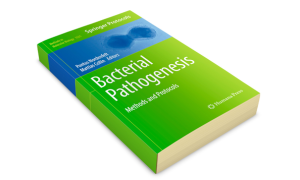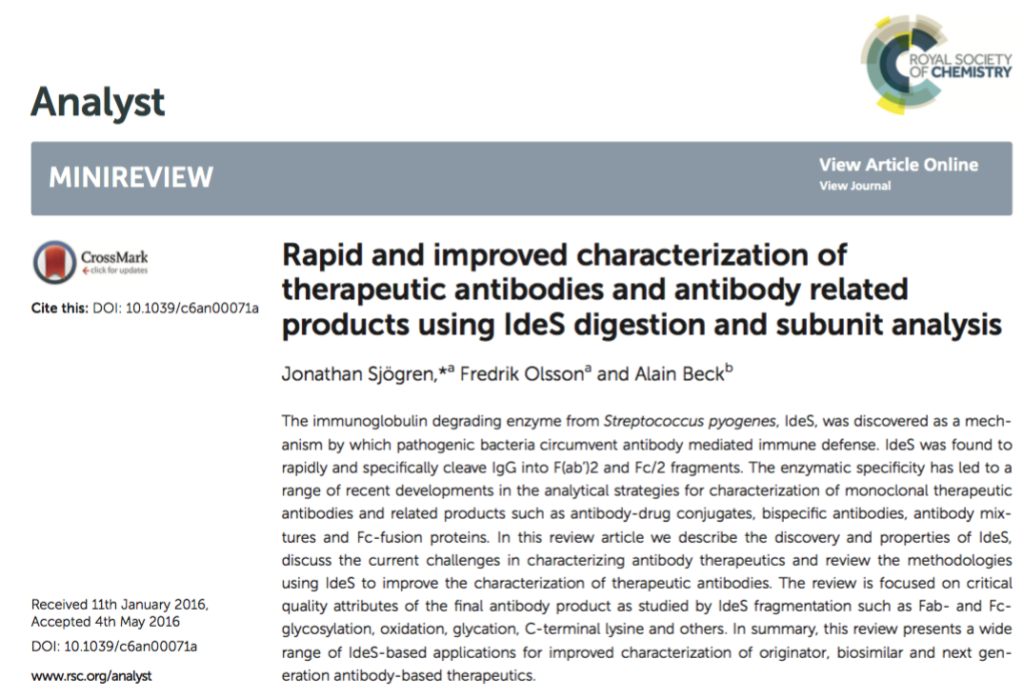Generate and purify Fab fragments from human and mouse IgG using Genovis SmartEnzymes
Antibodies are important tools in several scientific research areas, and sometimes it is necessary to cleave antibodies to generate antigen binding (Fab) fragments. The Fab fragments can be used within e.g. imaging, removal of effector functions, infection biology, binding studies, and mass spectrometry.
In a recently published book (“Bacterial Pathogenesis, Methods and Protocols”, Humana Press, 2017), the Genovis Team has written a chapter of how to generate and purify Fab fragments from human and mouse IgG by using the bacterial proteases IdeS (FabRICATOR), SpeB (FabULOUS) and Kgp (GingisKHAN).
- The FabRICATOR enzyme is derived from Streptococcus pyogenes, and generates F(ab’)2 fragments in all human IgG subclasses. A homogenous pool of Fab’ fragments can be generated under mild reducing conditions. Read more about FabRICATOR here.
- The FabULOUS enzyme is also derived from Streptococcus pyogenes, and can be used to digest mouse IgG. Using light chain affinity resins, Fab fragments can be purified. Read more about FabULOUS here.
- The GingisKHAN enzyme is derived from Porphyromonas gingivalis, digests the upper hinge and generates intact Fab fragments from human IgG1 in one step. Using a CH1-specific affinity resin, the Fab fragments can be purified. Read more about GingisKHAN here.

Find the full text paper here:
Sjögren, J. et al., 2017. Generating and Purifying Fab Fragments from Human and Mouse IgG Using the Bacterial Enzymes IdeS, SpeB and Kgp. Methods in Molecular Biology, 1535, pp.319–329.
First GingisKHAN Publication
Researchers at LFB Biotechnologies have published the first paper using the Genovis SmartEnzyme GingisKHAN. GingisKHAN digests human IgG1 antibodies in the upper hinge, resulting in intact Fab and Fc fragments. The paper published in Journal of Chromatography describes how charge variants of therapeutic antibodies are characterized in a long term stability study using ion exchange chromatography coupled to native mass spectrometry. FabRICATOR was applied to digest antibodies below the hinge region and generated good separation of the Fc fragments. To specifically investigate any variations in the Fab domain, GingisKHAN was applied to digest the antibodies in the upper hinge and generate Fab fragments of about 50 kDa. The specific digestion site in combination with native MS allowed both oxidations (+16 Da) and deamidations (+1 Da) to be characterized.
Monitoring mAb afucosylation using GlycINATOR
The level of core fucosylation on therapeutic antibodies have major impact on antibody dependent cell cytotoxicity. To study the core fucosylation, Suli Liu and Li Zang at Biogen have published a method using deglycosylation by GlycINATOR, reduction of the antibody and LC-MS analysis. Using this methodology the scientist could quantify the fucosylation within 1 h, including sample preparation and analysis. Liu and Zang argue that this methodology is particularly well suited for high-troughput analysis cell line development and process development of therapeutic mAbs.
Genovis and Promega sign global license agreement and settle litigation
Genovis has reached a settlement in its patent infringement lawsuit with Promega Corp. and agreed to a royalty bearing, worldwide license to the patents-in-suit.
The settlement ends all ongoing patent-infringement claims between the parties and Promega has agreed to a royalty bearing, worldwide license to the patents-in-suit, thereby ending the lawsuit between the parties. The specific terms of the contract are confidential.
“I am pleased we were able to reach a settlement with a favorable business solution that accommodates Genovis’ long term growth strategy,” says Fredrik Olsson, CEO of Genovis.
FabULOUS Fab Kit – Intact Fab fragments from mouse IgG
The FabULOUS (SpeB) enzyme digests IgG in the hinge region. The FabULOUS Fab kit is designed for digestion and purification of Fab fragments from mouse IgG antibodies. Incubation at optimized reducing conditions generates intact Fab, easily purified with spin columns.
- Digestion in the hinge with FabULOUS
- Affinity purification of Fab fragments using the light chain
- Preparation of Fab fragments from mouse IgG in less than 2 h
The Genovis team has published a review on FabRICATOR (IdeS) characterization of therapeutic antibodies
The Genovis team has together with Alain Beck, Senior Director Antibody Physico-Chemistry at Pierre Fabre, published a review article summarizing all the current publications using FabRICATOR (IdeS) for characterization of therapeutic antibodies and related products.
“The specificity and robustness of the IdeS digestion is critical for generating a homogenous pool of fragments. Combined with the limited sample preparation and ease of data interpretation, the IdeS enzyme has transformed antibody subunit analysis” Sjögren et al. 2016.
The review is published in The Analyst and demonstrates the wide use of FabRICATOR to study critical antibody qualities such as:
- Fc-glycosylation
- Oxidation
- Drug antibody ratio on ADCs
- Deamidation
The FabRICATOR enzyme specifically digests antibodies into F(ab’)2 and Fc/2 fragments that can be reduced to antibody subunits (Fd, LC and Fc/2) and studied with high mass accuracy.
Learn more on the FabRICATOR enzyme

[New Reference] Using HILIC to study antibody subunits
Researchers at the University of Geneva led by Davy Guillarme has used a novel form of HPLC column, based on wide-pore hybrid silica bonded with amide ligand, and developed an HILIC analytical workflow for characterization of biopharmaceuticals. The scientists used FabRICATOR to fragment trastuzumab to subunits and studied the fragments using the new column with HILIC separation. The results showed that the method effectively separated important glycoforms of the Fc/2 fragment. The developed method is compatible with mass spectrometry, does not need high mobile phase temperatures, and allows serial coupling of columns.
GingisREX – New Enzyme from Genovis

Genovis expands the protease portfolio with GingisREX – a new enzyme with unique specificity for arginine residues. The GingisREX protease can be used for peptide mapping, protein sequencing and post-translational modification analysis using mass spectrometry.
New references on IgG glycosylation, glycation and ADC characterization using IgGZERO and FabRICATOR
New references are out using Genovis enzymes to study antibody glycation, pairing of high-mannose glycans and ADC characterization using CE-MS.
Genovis AB has signed a strategic cooperation agreement with Alphalyse A/S
The cooperation agreement will provide Genovis with access to Alphalyse’s expertise in mass spectrometry while Alphalyse will have the opportunity to offer its customers analyses based on Genovis’ unique enzymes for antibodies and other pharmaceutical proteins. Read more »


